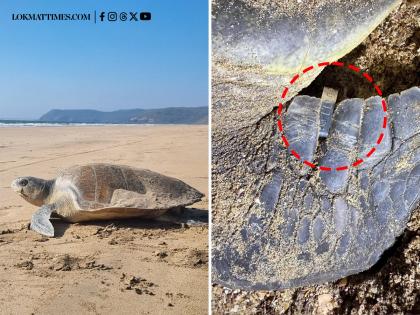Rare Olive Ridley Turtle Travels 3,500 km to Lay Eggs on Maharashtra’s Guhagar Beach
By Amit Srivastava | Updated: April 15, 2025 09:44 IST2025-04-15T09:41:52+5:302025-04-15T09:44:09+5:30
Navi Mumbai: In an inspiring display of resilience, an Olive Ridley turtle has made a historic journey of 3,500 km ...

Guhagar Beach Welcomes Olive Ridley Turtle After 3,500 km Migration from Odisha
Navi Mumbai: In an inspiring display of resilience, an Olive Ridley turtle has made a historic journey of 3,500 km from the Gahrimatha Marine Sanctuary in Odisha to Guhagar Beach in Ratnagiri district, Maharashtra. The turtle’s arrival has been marked by the successful laying of 120 eggs at the coastal site.
The Mangrove Division-South Konkan confirmed that 107 of these eggs hatched successfully, and the hatchlings were promptly released into the sea.
The turtle, tagged with the identification number ‘03233,’ was first spotted at Guhagar Beach on January 31, 2025. Divisional Forest Officer Kanchan Pawar shared this update with the NatConnect Foundation.
The local Kasav Mitra (Friends of Turtles) volunteers, working under the guidance of the Mangrove Foundation, ensured the safety of the turtle and its eggs. After laying its clutch, the turtle was safely released back into the sea. Between March 23 and March 26, 107 hatchlings emerged and made their way to the ocean, with the highest number of 74 hatchlings counted on March 24.
This particular turtle was tagged as ‘03233’ at Gahrimatha Beach in Odisha on March 21, 2021. Over the course of nearly two years, it made an extraordinary journey to reach the shores of Guhagar, traveling an impressive 3,500 km.
Dr. Basudev, a senior scientist at the Zoological Survey of India (ZSI) who has been involved in turtle tagging, expressed his surprise at finding this turtle on the western coast. He emphasized that turtles play a vital role in marine ecosystems by controlling jellyfish populations and helping maintain the health of marine habitats.
NatConnect Foundation Director B.N. Kumar also remarked on the turtle’s long migration, noting that while the metal tagging process provides limited information about the turtle’s journey, it helps raise awareness about the species. Tagging reveals the basic details such as the date and location of tagging, but the turtle's route and stopovers remain a mystery.
The Olive Ridley Project highlights the crucial role of sea turtles in global biodiversity. These turtles help in the transfer of marine organisms between reefs, seagrass beds, and the open ocean, which contributes to the health of ocean ecosystems. After laying their eggs in nests on the shore, they return to the sea to continue their migratory journey.
Open in app